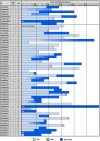A Meta-Analysis of α-Synuclein Multiplication in Familial Parkinsonism
- PMID: 30619023
- PMCID: PMC6297377
- DOI: 10.3389/fneur.2018.01021
A Meta-Analysis of α-Synuclein Multiplication in Familial Parkinsonism
Abstract
Chronic alpha-synuclein (SNCA) overexpression is a relatively homogenous and well-defined cause of parkinsonism and dementia. Parkinson's disease (PD), PD with dementia, dementia with Lewy bodies and multiple system atrophy all manifest in SNCA multiplication families. Herein we summarize genealogic, clinical and genetic data from 59 families (25 not previously published) with parkinsonism caused by SNCA multiplications. Longitudinal clinical assessments and genealogic relationships were documented for all family members. All probands were genotyped with an Illumina MEGA high-density genotyping array to identify copy number variants (CNV) and enable SNCA multiplication breakpoints to be defined. Three SNCA short tandem repeat (STR) markers were genotyped in all available samples to validate genomic dosage and inheritance. A web-application was built as a forum for future data sharing. CNV analysis identified 49 subjects with heterozygous SNCA duplication (CNV3), 2 with homozygous duplication (CNV4) and 7 with a triplication mutation (CNV4). Clinical presentations varied greatly throughout the cohort. SNCA dosage correlates with disease onset (mean age of onset CNV3: 46.9 ± 10.5 years vs. 34.5 ± 7.4 CNV4, p = 0.003). Atypical or more severe clinical courses were described in several patients and dementia was noted in 50.9% of the probands. Neither the multiplication size (average 2.05 ± 2.45 Mb) nor the number of genes included (range 1-50) was associated with motor symptom onset or dementia. Families with SNCA multiplication are rare and globally-distributed. Nevertheless, they may both inform and benefit from the development of SNCA targeted therapeutic strategies relevant to the treatment of all alpha-synucleinopathies.
Keywords: SNCA; clinical phenotype; dementia; duplication; parkinsonism; triplication.
Figures




References
LinkOut - more resources
Full Text Sources
Miscellaneous

